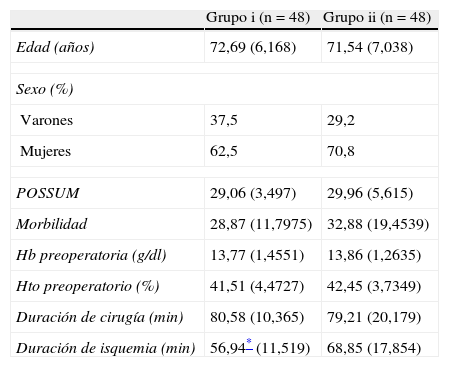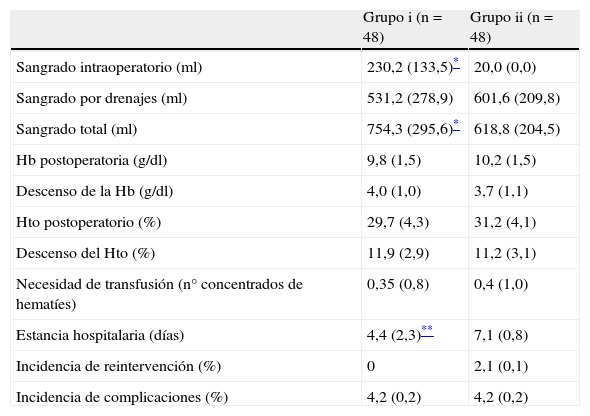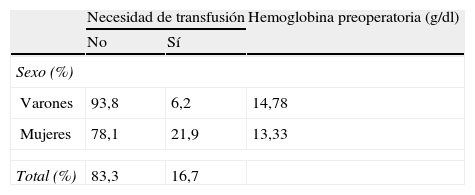Analizar si en las artroplastias de rodilla, retirar intraoperatoriamente la isquemia para realizar hemostasia reduce el sangrado, la necesidad de transfusión, la incidencia de complicaciones, la incidencia de reintervención y la estancia hospitalaria.
Pacientes y métodoEstudio no aleatorio, prospectivo, descriptivo, observacional, de pacientes sometidos a artroplastia primaria de rodilla con un único anestesiólogo y 2 equipos quirúrgicos, que realizaban la misma técnica quirúrgica y modelo de prótesis, con 2 pautas de retirada de isquemia y manejo de los drenajes. Se dividió a los pacientes en 2 grupos. En el grupo i se liberaba el manguito de isquemia intraoperatoriamente, antes del cierre de la herida, dejando los drenajes sin vacío. En el grupo ii se liberaba el manguito cuando el miembro ya estaba vendado y los drenajes se conectaban a vacío. Los parámetros registrados fueron la hemorragia intraoperatoria, sangrado por drenajes, sangrado total, evolución de la hemoglobina y hematocrito, incidencia de complicaciones y de reintervención, necesidades de transfusión y estancia hospitalaria.
ResultadosSe incluyó a 100 pacientes. El sangrado intraoperatorio del grupo i fue de 230,0mL y de 20,0mL en el ii (p<,05). El sangrado por drenajes en el grupo i fue de 531,2ml y de 601,6ml en el grupo ii (p>0,05). El sangrado total en el grupo i fue de 754,3mL y en el grupo ii de 621,6mL. Existiendo diferencias estadísticamente significativas en ambos casos (p<0,05). La incidencia de transfusión en ambos grupos fue del 16,7%. No se encontraron diferencias significativas entre los grupos en lo referente a la incidencia de complicaciones médicas ni de reintervención. Se observó mayor estancia hospitalaria en el grupo ii.
ConclusiónEn nuestro estudio, la necesidad de transfusión en las artroplastias de rodilla no está influida por el momento de retirada del manguito de isquemia. La incidencia de reintervención y de complicaciones postoperatorias tampoco guarda relación con el momento de retirada del torniquete. La hemoglobina preoperatoria es el único factor predictivo de transfusión en nuestro estudio.
To determine whether the removal of the ischaemia tourniquet to perform haemostasis during knee replacement surgery, reduces bleeding, the need for transfusions, the incidence of complications, the incidence of further surgery, and the hospital stay.
Patients and methodA non-randomised, prospective, descriptive and observational study was conducted on patients subjected to primary knee replacement with only one anaesthetist and 2 surgical teams. The same surgical technique and prosthesis model was used, with 2 schemes for ischaemia removal and drainage management. The patients were divided into 2 groups. In group i, the ischaemia tourniquet was released during the operation, before wound closure, and leaving the drainages without a vacuum. In group ii the tourniquet was released when the limb was bandaged and the drainages were connected to a vacuum. The parameters recorded were; bleeding during surgery, bleeding due to the drainages, monitoring the haemoglobin and haematocrit, incidence of complications and further surgery, transfusion needs, and hospital stay.
ResultsThe study included 100 patients. The mean bleeding during surgery was 230,0mL in group i and 2,0mL in group ii (P<.05). The bleeding due to the drainages in group i was 531,2mL and 601,6mL in Group ii (P>.05). The total bleeding was 754,3mL in group i and 621,6mL in group ii. There were statistically significant differences in both cases (P<.05). The transfusion incidence in both groups was 16,7%. There were no significant differences between either group as regards medical complications or further surgery. A longer hospital stay was observed in group ii.
ConclusionIn this study, the need for transfusions in knee replacement surgery is not influenced by the time of releasing the ischaemia tourniquet. There is also no relationship between the incidence in postoperative complications and further surgery and the time of removing the tourniquet. The preoperative haemoglobin was the only predictive factor of transfusion in our study.
Artículo
Comprando el artículo el PDF del mismo podrá ser descargado
Precio 19,34 €
Comprar ahora










